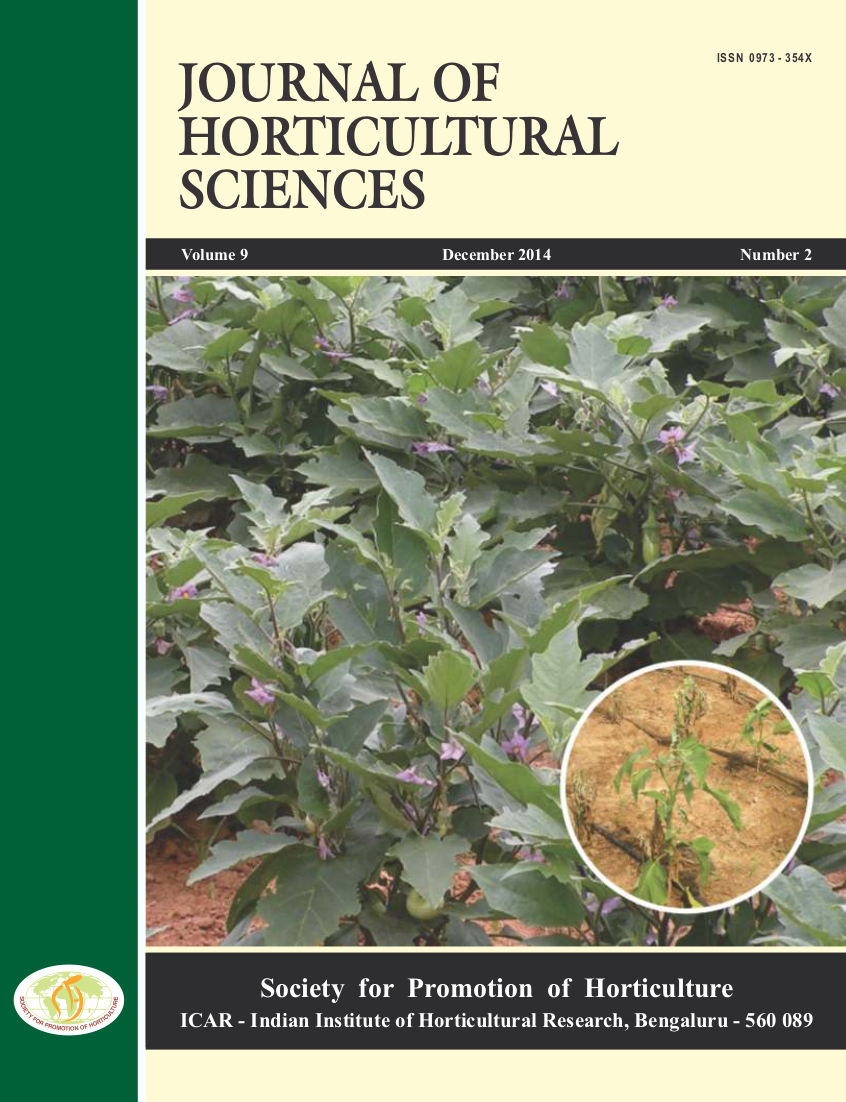Effect of Pruning on Productivity in Sweet Orange
DOI:
https://doi.org/10.24154/jhs.v9i2.199Keywords:
Canopy Management, Fruit Production and Quality, Sweet Orange, Laterite SoilAbstract
To sustainable production of quality fruits in eight year old sweet orange plants of cv. Mosambi budded onto Citrus jambheri rootstock, and grown in laterite soil at Jhargram, Paschim Medinipur, a canopy management trial was conducted for two consecutive years. The treatments included T1: No pruning; T2: Removal of dead and dry shoots and branches; T3: T2 + Removal of thin shoots and water-sprouts arising from the leaders at 90° angle; T4: T3 + Removal of selected laterals; T5: T4 + Removal of selected leaders for formation of open-centre-canopy. Randomized Block Design with five replications was set up. Results indicated that fruit production improved with regular pruning. Significantly high fruit retention (68%) with maximum number of fruits (250) was recorded in plants where open-canopy was maintained by judicious removal of the leaders, laterals, thin shoots and dead wood. Trees with open-canopy not only resulted in 71.4% increase in fruit number, but also enhanced fruit weight by 17.9% over Control. Significantly good fruit quality in terms of TSS, total sugars and Vitamin C content was recorded in fruits from the open canopy treatment. Dry weight of shoots / branch was lowest (1.50kg) in open-canopy treatment and highest in the unpruned Control (3.0kg). Foliar N, P and K status did not vary significantly with different pruning practices.Downloads
References
A.O.A.C. 1990. Official methods of Analysis (15th edn.). Association of official Agricultural Chemists, Washington D.C.
Bevingten, K.B. 1980. Response of Valencia orange trees in Australia to hedging and topping. Procs. Fla. State Hort. Soc., 93:65-66
Bhargava, B.S. 1999. Leaf analysis for diagnosing nutrient need in fruit crops. Indian Hort., 43:6-8
Ghosh, S.N. and Tarai, R.K. 2007. Performance of Mosambi sweet orange on different rootstocks grown in laterite soil in West Bengal. J. Hortl. Sci., 2:153-155
Joubert, F.J., Plessis, M.H. du, Stassen, P.J.C. and du Plassis, M.H. 2000. Pruning strategies to alleviate overcrowding in high density citrus orchard. J. Appl. Hort., 2:1-5
Nath, J.C. 1994. Effect of pruning intensity on growth, yield and quality of Assam lemon (Citrus limon). Haryana J. Hortl. Sci., 23:281-285
Philips, R.L. 1978. Hedging and topping citrus in high density plantings. Procs. Fla. State Hort. Soc., 91:43-46
Sharma, J.N., Josan, J.S. and Thind, S.K. 1997. Effect of pruning intensities on the productivity of Kinnow mandarin. Indian J. Hort., 54:304-307
Tayde, G.S. and Ingle, H.V. 1997. Studies on the effect of severity of pruning on growth, yield and quality of Nagpur mandarin. Procs. Nat’l. Symp., NRC Citrus, Nagpur, pp. 185-187
Downloads
Published
Issue
Section
License
Copyright (c) 2014 S N Ghosh, B Bera (Author)

This work is licensed under a Creative Commons Attribution-NonCommercial-ShareAlike 4.0 International License.
Authors retain copyright. Articles published are made available as open access articles, distributed under the terms of the Creative Commons Attribution-NonCommercial-ShareAlike 4.0 International License, which permits unrestricted non-commercial use, distribution, and reproduction in any medium, provided the original author and source are credited. 
This journal permits and encourages authors to share their submitted versions (preprints), accepted versions (postprints) and/or published versions (publisher versions) freely under the CC BY-NC-SA 4.0 license while providing bibliographic details that credit, if applicable.





 .
. 











